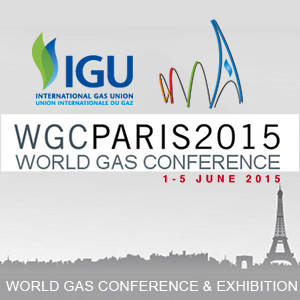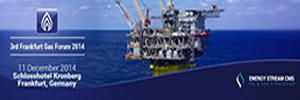Tel Aviv, November 19, 2014. Delek Group (TASE: DLEKG, OTCQX: DGRLY) (“the Company”) further to what was stated in section 1.7.9 (K) of the Company’s Periodic Report dated 31 March 2014 (ref. no. 2014-01-030843) (“the Periodic Report”), and in accordance with information provided to the partners Delek Drilling – Limited Partnership and Avner Oil Exploration – Limited Partnership (“the Partnerships”) by the operator of the Aphrodite natural gas reservoir in Block 12, Cyprus (“the Reservoir” or “Aphrodite Reservoir), Noble Energy International Ltd ( “the Operator” or “Noble Cyprus”), mainly based on data collected from the “Aphrodite-2” well in License Area 370 / “Ishai” (“Ishai License”), as recently informed to Noble Cyprus as part of the exchange of information agreement between the governments of Israel and Cyprus, the Company has issued an Immediate Report concerning the update of contingent and prospective resources (natural gas and condensate) in the Aphrodite Reservoir1, as follows:
1. Contingent resources in the Aphrodite Reservoir
- Volumetric data
Based on the report that the Partnerships have received from Netherland Sewell and Associates Inc. (“the Assessor” or “NSAI”), prepared in accordance with the rules of the Petroleum Resources Management System (SPE-PRMS) (“Resources Report”), the contingent resources of natural gas and condensate in the Aphrodite Reservoir, classified as “Development Pending”, as at September 30, 2014 were as stated below:
1 It should be noted that the overwhelming majority of the Aphrodite Reservoir is located in the Exclusive Economic Zone of Cyprus, and a minority in the area of the Ishai License, which is in the Israeli Exclusive Economic Zone.
|
Total percentage belonging to the Company’s capital rights holders (Gross)2 |
Total Oil Resource |
Probability |
Target |
||
|
Condensate |
Natural gas |
Condensate |
Natural gas |
||
|
0.0 |
2.5 |
0.0 |
14.9 |
Low Estimate |
Sand A |
|
0.0 |
13.2 |
0.2 |
79.6 |
Best Estimate |
|
|
0.0 |
16.1 |
0.2 |
96.5 |
High Estimate |
|
|
0.4 |
259.3 |
2.6 |
1558.4 |
Low Estimate |
Sand C |
|
0.7 |
351.5 |
4.2 |
2112.4 |
Best Estimate |
|
|
1.0 |
455.4 |
6.0 |
2737.2 |
High Estimate |
|
|
0.0 |
12.9 |
0.1 |
77.7 |
Low Estimate |
Sand D1U |
|
0.2 |
97.9 |
1.2 |
588.4 |
Best Estimate |
|
|
0.3 |
142.4 |
1.9 |
856.0 |
High Estimate |
|
|
0.0 |
18.3 |
0.2 |
109.7 |
Low Estimate |
Sand D1L |
|
0.1 |
72.8 |
0.9 |
437.3 |
Best Estimate |
|
|
0.2 |
90.1 |
1.2 |
541.6 |
High Estimate |
|
|
0.0 |
20.8 |
0.2 |
125.2 |
Low Estimate |
Sand D2 |
|
0.1 |
51.5 |
0.6 |
309.5 |
Best Estimate |
|
|
0.2 |
74.6 |
1.0 |
448.2 |
High Estimate |
|
2 Since the share of the Republic of Cyprus in the gas produced from Block 12 depends on the rate of production, at the time of this report it is not known and cannot be estimated, since at this report date the percentage (net) of the resources of the Company’s capital rights holders cannot be determined. Accordingly, in the above table the percentage (gross) of the Company’s capital rights holders is included, before deducting the share of the Republic of Cyprus, in accordance with the provisions of the Production Sharing Contract and before royalties, as detailed in section 1.7.9 (G) of the Periodic Report.
- In the Resources Report it is noted that the resources are contingent, inter alia, by the project approval, including the development plan and a reasonable forecast for natural gas sales. Similarly, it is noted that the Resources Report does not include an economic analysis of the oil asset and is based on the development of similar reservoirs, and best estimate contingent recourses have a reasonable likelihood for commercial production.
- To the best of the Company’s knowledge, the Operator is assessing various development possibilities for the Aphrodite Reservoir, including considering the possibility to combine its development with the development plans of nearby reservoirs located in the Israeli Exclusive Economic Zone, including the “Leviathan” natural gas reservoir. In the light of the estimated scope of the contingent and prospective natural gas resources in the Aphrodite Reservoir, and in the light of the limited scope of the potential local gas market in Cyprus, the main potential market for these resources is the international market. At the date of this report, the partners in Block 12 in Cyprus are assessing, together with the Cyprus government, regional development possibilities to export natural gas from the Aphrodite Reservoir, including via a pipeline to regional markets, including Egypt. The partners in Block 12 and the Cyprus government intend to formulate a development plan for the Aphrodite Reservoir under the Production Sharing Contract, which will include inter alia constructing the required infrastructure for exporting natural gas. For details about the gas market in Cyprus, see section 1.6 of the Periodic Report, and for details about the possibility of exporting gas, see section 1.7.14(b) of the Periodic Report.
- It should be noted that at this report date it is not possible to set an estimated timetable to formulate and/or implement a development plan for the Aphrodite Reservoir, until such time as various plans for trading in the gas from the reservoir and development have been considered and formulated.
- It should be emphasized that every variation in development has completely different timetable and operating costs, and therefore until the preferred variant has been selected it is not possible to reasonably assess the timetables and development budget of the reservoir. Similarly it is should be noted that any development plan will naturally require extensive regulatory, commercial and financial arrangements in order to funnel the lion’s share of the natural gas resources of the Aphrodite Reservoir to export.
Warning – there can be no certainty that it will be possible commercially to produce anything from the contingent resources.
2. Prospective resources in the Aphrodite Reservoir
- Volumetric data
According to the Resources Report, as at September 30, 2014, the prospective resources of natural gas and condensate from the Aphrodite Reservoir are as shown below:Total percentage belonging to the Company’s capital rights holders (Gross)3
Total Oil Resource
(Gross)Probability
Target
Condensate
Million BarrelsNatural gas
BCFCondensate
Million BarrelsNatural gas
BCF0.0
1.0
0.0
6.2
Low Estimate
Sand A
0.0
2.1
0.0
12.5
Best Estimate
0.0
2.5
0.0
15.1
High Estimate
0.0
5.8
0.1
34.8
Low Estimate
Sand C
0.0
7.9
0.1
47.2
Best Estimate
0.0
10.2
0.1
61.2
High Estimate
0.0
19.9
0.2
119.9
Low Estimate
Sand D1U
0.1
70.7
0.8
424.8
Best Estimate
0.2
97.5
1.3
586.0
High Estimate
0.0
26.4
0.3
158.6
Low Estimate
Sand D1L
0.1
60.8
0.7
365.7
Best Estimate
0.2
83.9
1.1
504.3
High Estimate
High Estimate0.0
9.4
0.1
56.6
Low Estimate
Sand D2
0.0
28
0.3
168.3
Best Estimate
0.6
286.1
3.8
1719.9
High Estimate
3 Before deducting the share of the Republic of Cyprus, in accordance with the provisions of the Production Sharing Contract and before royalties. Since the share of the Republic of Cyprus in the gas produced from Block 12 depends on the rate of production, at the time of this report it is not known and cannot be estimated, since at this report date the percentage (net) of the resources of the Company’s capital rights holders cannot be determined. Accordingly, in the above table the percentage (gross) of the Company’s capital rights holders is included, before deducting the share of the Republic of Cyprus, in accordance with the provisions of the Production Sharing Contract and before royalties, as detailed in section 1.7.9 (G) of the Periodic Report.
- The Resources Report has been prepared based upon a three dimensional seismic survey conducted in 2009 by Petroleum Geo-Services, whose processing was completed in 2013 (“the 3D Survey”), based on data gathered at the “Aphrodite A1” and “Aphrodite A2” wells in the Aphrodite Reservoir, at the “Aphrodite-2” well in the Ishai License and also at similar reservoirs around the world.
- Below are the basic parameters for calculating the various scenarios:
Since the prospective resources in the reservoir are located in separate fault blocks, below are shown the basic parameters that were employed to calculate various scenarios in each of the fault blocks separately:
Central fault block
|
Target |
Area |
Gross Thickness |
Gross Rock Volume (Acre*Feet) |
||||||
|
|
High |
Best |
Low |
High |
Best |
Low |
High |
Best |
Low |
|
Sand D1U |
5,872 |
4,721 |
3,503 |
88 |
88 |
80 |
515,602 |
415,292 |
278,606 |
|
Sand D1L |
5,948 |
5,530 |
4,846 |
145 |
143 |
141 |
860,233 |
790,073 |
682,605 |
|
Sand D2 |
6,138 |
2,901 |
2,498 |
266 |
86 |
67 |
1,631,647 |
249,302 |
168,518 |
|
Target |
Gas Saturation |
Porosity |
Net-to-Gross |
||||||
|
|
High |
Best |
Low |
High |
Best |
Low |
High |
Best |
Low |
|
Sand D1U |
0.68 |
0.71 |
0.62 |
0.22 |
0.22 |
0.19 |
0.57 |
0.51 |
0.37 |
|
Sand D1L |
0.66 |
0.69 |
0.67 |
0.23 |
0.23 |
0.20 |
0.31 |
0.26 |
0.17 |
|
Sand D2 |
0.73 |
0.75 |
0.63 |
0.23 |
0.23 |
0.20 |
0.52 |
0.37 |
0.28 |
|
Target |
Gas Recovery Factor |
Gas Formation Volume Factor (SCF/RCF) |
||||
|
|
High |
Best |
Low |
High |
Best |
Low |
|
Sand D1U |
0.70 |
0.65 |
0.6 |
378 |
378 |
378 |
|
Sand D1L |
0.70 |
0.65 |
0.6 |
378 |
378 |
378 |
|
Sand D2 |
0.70 |
0.65 |
0.6 |
379 |
379 |
379 |
Southwestern fault block
|
Target |
Area |
Gross Thickness |
Gross Rock Volume (Acre*Feet) |
||||||
|
|
High |
Best |
Low |
High |
Best |
Low |
High |
Best |
Low |
|
Sand A |
2,424 |
2,424 |
2,424 |
21 |
21 |
21 |
50,690 |
50,690 |
50,690 |
|
Sand C |
623 |
623 |
623 |
106 |
106 |
106 |
66,322 |
66,322 |
66,322 |
|
Sand D1U |
964 |
964 |
31 |
84 |
84 |
16 |
81,128 |
81128 |
500 |
|
Sand D1L |
685 |
474 |
280 |
98 |
90 |
69 |
67,014 |
42,653 |
19,407 |
|
Sand D2 |
990 |
15 |
15 |
129 |
8 |
8 |
128,163 |
117 |
117 |
|
Target |
Gas Saturation |
Porosity |
Net-to-Gross (decimal) |
||||||
|
|
High |
Best |
Low |
High |
Best |
Low |
High |
Best |
Low |
|
Sand A |
0.58 |
0.63 |
0.58 |
0.19 |
0.19 |
0.16 |
0.23 |
0.19 |
0.13 |
|
Sand C |
0.72 |
0.76 |
0.73 |
0.21 |
0.21 |
0.20 |
0.53 |
0.41 |
0.37 |
|
Sand D1U |
0.68 |
0.71 |
0.62 |
0.22 |
0.22 |
0.19 |
0.57 |
0.51 |
0.37 |
|
Sand D1L |
0.66 |
0.69 |
0.67 |
0.23 |
0.23 |
0.20 |
0.31 |
0.26 |
0.17 |
|
Sand D2 |
0.73 |
0.75 |
0.63 |
0.23 |
0.23 |
0.20 |
0.52 |
0.37 |
0.28 |
|
Target |
Gas Recovery Factor |
Gas Formation Volume Factor (SCF/RCF) |
||||
|
|
High |
Best |
Low |
High |
Best |
Low |
|
Sand A |
0.70 |
0.65 |
0.60 |
375 |
375 |
375 |
|
Sand C |
0.70 |
0.65 |
0.60 |
378 |
378 |
378 |
|
Sand D1U |
0.70 |
0.65 |
0.60 |
378 |
378 |
378 |
|
Sand D1L |
0.70 |
0.65 |
0.60 |
378 |
378 |
378 |
|
Sand D2 |
0.70 |
0.65 |
0.60 |
379 |
379 |
379 |
- Material risks associated with continuation of the process: The material risks associated with continuation of the process are related to proving commercial findings, including, inter alia, the costs of appraisal and development of the reservoir. Similarly, there are risks in proving the prospective resources in the fault blocks that have not yet been drilled. For details of the risk factors involved in exploration operations, see section 1.7.30 of the Periodic Report.
- The estimated probability for success of each of the risk factors in the drilling and the statistical estimate of the geological probability of finding natural gas in the fault blocks in which the prospective resources are located are as follows (in percentages):
Central fault block
|
Target |
Completeness of trap |
Reservoir quality |
Source quality |
Timing and migration |
Total |
|
Sand D1U |
100 |
95 |
100 |
100 |
95 |
|
Sand D1L |
100 |
95 |
100 |
100 |
95 |
|
Sand D2 |
100 |
95 |
100 |
100 |
95 |
Southwestern fault block
|
Target |
Trap integrity |
Reservoir quality |
Source quality |
Timing and migration |
Total |
|
Sand A |
100 |
70 |
100 |
100 |
70 |
|
Sand C |
100 |
95 |
100 |
100 |
95 |
|
Sand D1U |
100 |
90 |
100 |
100 |
90 |
|
Sand D1L |
100 |
80 |
100 |
100 |
80 |
|
Sand D2 |
100 |
95 |
100 |
100 |
95 |
- Estimate of the probability of development for commercial production: For details see section 1(b)-(e) above.
- Reasons of the Company concerning the basis for the basic parameters employed in the calculation of the scenarios: The parameters used in the calculation of the various estimates were mainly based on data collected at the “Aphrodite A1” and Aphrodite A2 wells in the Aphrodite Reservoir, at the “Aphrodite-2” well in the Ishai License, on data from the 3D Seismic Survey and general information from similar targets and reservoirs.
3. In the Resources Report NSAI has noted, inter alia, a number of assumptions and reservations, including:
- Estimates of the contingent resources have not been adjusted to reflect development risks;
- NSAI did not visit the oilfield and did not check the mechanical operation of the installations and wells or their condition;
- NSAI did not assess possible exposure arising from environmental issues. Furthermore, NSAI has noted that as of the Resources Report date it was not known of any possible liability related to environmental issues that might materially impact on the amount of resources estimated in the Resources Report or their degree of commerciality;
- The resources described in the Resources Report are located in an undeveloped site, and accordingly the assessment is based on estimates of the size off the reservoir and recovery efficiencies, drawing analogies from reservoirs with similar geological and reservoir characteristics.
4. Reconciliation between report data and data in previous reports dealing with the oil asset:
As previously stated, the overwhelming majority of the Aphrodite Reservoir is located in the Exclusive Economic Zone of Cyprus, and a minority in the area of the Ishai License, which is in the Israeli Exclusive Economic Zone. The reservoir is divided into several fault blocks, two of which have been drilled in the Exclusive Economic Zone of Cyprus by the Partnerships and the other partners in the Aphrodite Reservoir (“Aphrodite A-1” and “Aphrodite A-2” wells), and accordingly the resources in them have been qualified in the past by NSAI as contingent resources.
Based on the exchange of information agreement between the governments of Israel and Cyprus, Nobel Cyprus was recently informed by the Cyprus government of data gathered in the drilling in the area of the Ishai License, and of what was drilled in another fault block of the Aphrodite Reservoir, most of which is also located in the Exclusive Economic Zone of Cyprus. The data from “Aphrodite-2” is what caused the main changes in the present Resources Report, which reclassified the resources, previously defined as prospective, as contingent, increased by about 12% in the general volumes (prospective and contingent) of the natural gas and condensate resources in the reservoir, and an increase in the chances of success of the prospective resources that remain with this classification in the reservoir.
The material differences between the present Resources Report and the previous one for the Aphrodite Reservoir, which was published in the Periodic Report (“Previous Resources Report”), are as follows:
- The quantity of natural gas and condensate resources included in the Aphrodite Reservoir (prospective and contingent resources) increased in the low estimate by about 23% and in the high estimate by 1%. In the best estimate there was an increase of 12% from 4.05 TCF and 8.1 million barrels of condensate in the Previous Resources Report, to 4.54 TCF and 9 million barrels of condensate in the present Resources Report. The reduction in the range between the high and low estimates is acceptable with progress of the assessment program of the reservoir. The main factors in these changes were an increase in the estimate of the Gross Rock Volume of the reservoir, and an increase in the estimate in the gas saturation values, based on an updated analysis of the seismic survey and the logs of the three wells in the reservoir (“Aphrodite A-1”, “Aphrodite A-2” and “Aphrodite 2”).
- The “Aphrodite-2” well, which was drilled in the central fault block, has proven the existence of gas in sand layers A and C, and accordingly the resources in these sands, which in the Previous Resources Report were classified as prospective, have now been classified as contingent. In total, the quantity of contingent resources in the reservoir in the present Resources Report is 3.48 TCF in the best estimate, as compared with 1.78 TCF in the Previous Resources Report. The quantity of prospective resources in the reservoir in the present Resources Report is 0.99 TCF in the best estimate, as compared with 2.27 TCF in the Previous Resources Report.
- Since in the “Aphrodite-2” well, which was drilled on the edges of the central fault block, the various D sands (U1D, D1L, D2) were found to be wet (namely saturated in water), the resources in these sands, in the main section of this fault block (namely, in the upper part of the structure) have remained classified as forecast. In addition, there still remain prospective resources in the southwestern fault block. The estimate of the chances of success to find prospective resources throughout the reservoir has been updated as well, though not materially (in the southwestern fault block the estimated chance of success in D1L sands went up from 70% to 80%, while in the other sands the estimates remained the same. In the central fault block the chances of success of finding gas in the D1U, D1L and D2 sands were estimated in this report at 95% as against 90%, 70% and 95% in the Previous Report, respectively).
Warning – there can be no certainty that any part of the possible resources mentioned will be discovered. If they are discovered, no certainty that it will be commercially possible to produce anything from the resources. The prospective information is not an assessment based on reserves and contingent resources, which can only be assessed after a test drilling, if at all.
Warning concerning forecast information – the NSAI estimates concerning the contingent and prospective resources of natural gas and condensate in the Aphrodite Reservoir are forecast information in its meaning in the Securities Law. The above estimates are based, inter alia, on geological, geo-physical and other information received from the Operator from the wells in the reservoir and from wells in nearby reservoirs and are professional estimates and assessments of NSAI alone, for which there is no certainty. The volumes of natural gas and/or condensate that will be extracted in practice (if extracted), are likely to be different from the above assessments and estimates, inter alia, as a result of operational and technical conditions and/or regulatory changes and/or supply and demand conditions in the natural gas and/or condensate market and/or from actual operations in the reservoir. The above assessments and estimates are likely to be updated as additional information is gathered and/or as a result of an ensemble of factors related to exploration and production projects of oil and natural gas.
5. Glossary
Condensate – (1) hydrocarbon mixture produced from natural gas, separated from the gas and liquefied through cooling processes; (2) hydrocarbons found in an accumulation of gases in fault blocks, but become liquid when transferred from the reservoir below the surface; (3) hydrocarbons thickened through oil refining. In this report condensate is the type described in (2) of this clause.
Prospective Resources – defined by the PRMS as quantities of hydrocarbons that on a given date could be produced from reservoirs that have not yet been drilled.
Contingent Resources – defined by the PRMS as quantities of hydrocarbons that on a given date could be produced from known reservoirs through implementation of a development plan, but have still not been deemed produceable in economic terms, for one reason or another.
Project Maturity Sub-Class of Development Pending – defined by the PRMS as contingent resources found in a reservoir or exist economically justifiable circumstances in the foreseeable future.
Porosity – the relative volume of cavities in the rock.
Saturation – The relative volume of gas in the porosity.
Gross Rock Volume – the volume (gross) of the reservoir strata trapped in a given geological structure above the gas – water contact point.
Average Gross Thickness – the average thickness (gross) of the reservoir stratum on each geological structure.
Net-to-Gross – the ratio between the reservoir strata and the strata that are not reservoir that are trapped in a given geological structure.
Reservoir – a stratum or strata of rock characterized by relatively high porosity and penetratability, which facilitate the gathering and flow of liquids and gas. Sometimes also used to describe an oil and/or gas field.
Gas Formation Volume Factor – the volume of a cubic foot of natural gas at the pressure and temperature conditions of the reservoir, as it is brought below the surface.
Gas Recovery Factor or Recovery efficiencies – the ratio between produceable gas from the reservoir and the overall volume of gas in in place.
“BCF” – billion cubic feet.
6.
- The Company declares that all the above data has been prepared in accordance with the Petroleum Resources Management System (SPE-PRMS).
- Expert opinion of the assessor:
Attached to this report, by reference to the Immediate Report of Delek Drilling – Limited Partnership dated November 18, 2014 (ref. no. 2014-01-197250), Report of Contingent Resources of the Aphrodite Reservoir prepared by NSAI as of September 30, 2014. The agreement of NSAI for inclusion in this report is attached as an appendix.
Partners in the Aphrodite Reservoir and their percentage holdings are as follows:
| Noble Energy International Ltd. | 70% |
| Delek Drilling Limited Partnership | 15% |
| Avner Oil Exploration – Limited Partnership | 15% |
The full NSAI report is attached.
This is a convenience translation of the original HEBREW immediate report issued to the Tel Aviv Stock Exchange by the Company on November 18, 2014.
The Delek Group, Israel’s dominant integrated energy company, is the pioneering leader of the natural gas exploration and production activities that are transforming the Eastern Mediterranean’s Levant Basin into one of the energy industry’s most promising emerging regions. Having discovered Tamar and Leviathan, two of the world’s largest natural gas finds since 2000, Delek and its partners are now developing a balanced, world-class portfolio of exploration, development and production assets with total gross natural gas resources discovered since 2009 of approximately 40 TCF.
In addition, Delek Group has a number of assets in downstream energy, water desalination, and in the finance sector.
For more information on Delek Group please visit www.delek-group.com
Contact
| Dalia Black / Dina Vince Investor Relations Delek Group Tel: +972 9 863 8444 Email: [email protected] |




































